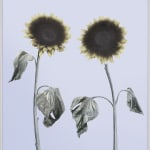Open a larger version of the following image in a popup:
 Photo Laurynas Skeisgiela
Photo Laurynas Skeisgiela
 Photo Laurynas Skeisgiela
Photo Laurynas Skeisgiela
Open a larger version of the following image in a popup:
 Photo Laurynas Skeisgiela.
Photo Laurynas Skeisgiela.
 Photo Laurynas Skeisgiela.
Photo Laurynas Skeisgiela.
Open a larger version of the following image in a popup:
 Photo Laurynas Skeisgiela.
Installation view Swallow, Vilnius
Photo Laurynas Skeisgiela.
Installation view Swallow, Vilnius
 Photo Laurynas Skeisgiela.
Installation view Swallow, Vilnius
Photo Laurynas Skeisgiela.
Installation view Swallow, Vilnius
Viltė Bražiūnaitė ≈ Tomas Sinkevičius Lithuanian, b. 1991
Honies, 2020
UV photography, archival pigment print on Hahnemühle FineArt paper, aluminium frame, glass
80 x 60 cm
82 x 62 x 2.5 cm Framed
82 x 62 x 2.5 cm Framed
Edition of 3 plus 2 AP
Further images
Photographs by Laurynas Skeisgiela <> Honies is a series of sunflower portraits taken with an ultraviolet camera on a hot and radiant summer day. The ultraviolet camera reveals how harmful...
Photographs by Laurynas Skeisgiela
<>
Honies is a series of sunflower portraits taken with an ultraviolet camera on a hot and radiant summer day. The ultraviolet camera reveals how harmful UV radiation invisible to the human eye illuminates the bodies. Ultraviolet photographs show dark stretches in the heads of sunflowers – bee landing sites. Bees see ultraviolet light and use it to collect pollen, directing their routes towards the patterned petals. The bees remember the plants they visited and collect pollen of the same colour and type during one flight – this consistency is also reflected in the series of the sunflower photographs.
Sunflowers were chosen for their exceptional appearance – their “heads”, facing the light as if solar collectors, following the path of the sun. Exhausted and withered by the heat of the sun, the sunflowers look into the camera lens and become images fluctuating between the styles of portrait photography and scientific documentation.
<>
Honies is a series of sunflower portraits taken with an ultraviolet camera on a hot and radiant summer day. The ultraviolet camera reveals how harmful UV radiation invisible to the human eye illuminates the bodies. Ultraviolet photographs show dark stretches in the heads of sunflowers – bee landing sites. Bees see ultraviolet light and use it to collect pollen, directing their routes towards the patterned petals. The bees remember the plants they visited and collect pollen of the same colour and type during one flight – this consistency is also reflected in the series of the sunflower photographs.
Sunflowers were chosen for their exceptional appearance – their “heads”, facing the light as if solar collectors, following the path of the sun. Exhausted and withered by the heat of the sun, the sunflowers look into the camera lens and become images fluctuating between the styles of portrait photography and scientific documentation.








